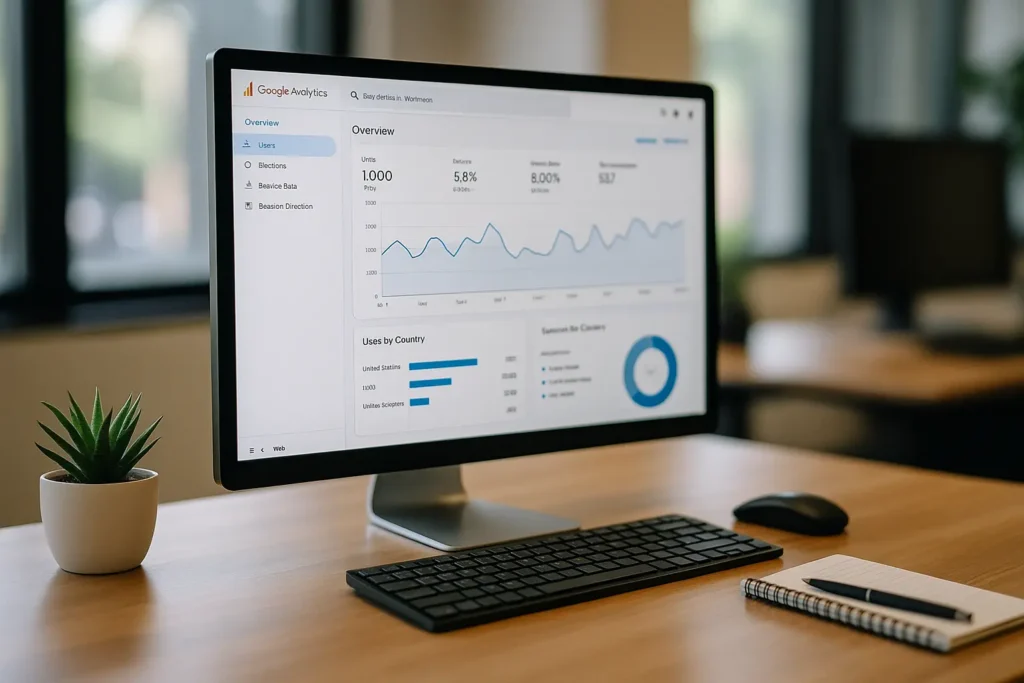In today’s digital realm, where every click counts, understanding how users interact with our websites is no longer a luxury but a necessity. Google Analytics stands as a beacon for those seeking to transform raw data into actionable insights. The world of analytics is vast, and unraveling its intricacies can seem daunting. Yet, within this complexity lies an opportunity to elevate our website’s performance through informed decisions. This journey begins with understanding the metrics and ends with crafting a digital experience that not only attracts but retains users.
As we delve into the world of analytics, we’ll explore the art of interpreting data, identifying opportunities for improvement, and enhancing the user experience. Together, we’ll unlock the secrets buried in the numbers, empowering our site to reach its full potential.
Understanding the Basics of Google Analytics
Every successful journey begins with a solid understanding of the basics. Google Analytics serves as our digital compass, guiding us through the labyrinth of data that every website inherently possesses. By grasping the foundational concepts of analytics, we can start to see patterns and trends that reveal much about our users and their behaviors.
At its core, Google Analytics is designed to track and report site traffic. It allows us to see where our traffic comes from, how users interact with our content, and which areas need improvement. The dashboard is our virtual cockpit, offering a bird’s-eye view of all activities on our site. It’s here that we can track KPIs such as the number of visitors, pages visited, and average session duration.
The true power of Google Analytics lies in its ability to provide a detailed view of our audience. Demographics, interests, and geographic location help us tailor our content to better meet the expectations of our users. By segmenting our audience, we gain the ability to tailor strategies to different user groups, enhancing overall engagement and satisfaction.
Understanding how our site performs can also be enriched by the concept of conversion tracking. By setting up goals and events, we can measure the effectiveness of our site in achieving business objectives. Whether it’s completing a purchase, signing up for a newsletter, or simply spending more time on a page, conversion tracking empowers us to make data-driven decisions.
In sum, mastering the basics of Google Analytics is like learning a new language. It opens up a world of insights and opportunities, allowing us to see our website through the eyes of our users and make informed changes.
Enhancing User Experience Through Detailed Data
In the competitive landscape of the digital world, user experience (UX) reigns supreme. It’s not just about drawing users in—it’s about keeping them engaged and delighted each time they visit. By leveraging data from Google Analytics, we can elevate the experience our website offers, fostering an environment that resonates with visitors.
The first step in enhancing UX is understanding how users navigate our site. By analyzing the user flow, we can identify which paths lead to successful interactions and which result in dead ends or drop-offs. This insight allows us to optimize navigation, ensuring users seamlessly find the content they seek.
Another critical component is page performance. Slow-loading pages deter users and increase bounce rates. With Google Analytics, we can pinpoint pages with high load times and take corrective action, ensuring our site runs smoothly and efficiently.
Content relevance is also vital. By examining search queries and behavior flow, we gain insight into what users are searching for and how well our content meets those needs. This understanding allows us to refine content strategies, providing fresh, pertinent material that keeps users returning.
Furthermore, tracking on-site interactions—such as clicks, scroll depth, and video plays—offers a glimpse into user engagement. This data helps us refine our design and content placement, ensuring that key messages and calls to action stand out.
Through the lens of Google Analytics, we can transform our website into a user-friendly haven. By continuously monitoring and adjusting based on data-driven insights, we enhance the overall user experience, ensuring our site not only meets but exceeds user expectations.
Optimizing Content for SEO and User Engagement
In the vast universe of the internet, standing out is a challenge. Content is king, but only if it reaches the right audience at the right time. Herein lies the power of Search Engine Optimization (SEO) paired with user engagement—a dynamic duo that can propel our site to new heights.
Google Analytics serves as our flashlight, illuminating areas where our content shines and where it falters. By diving into metrics such as traffic sources and search terms, we gain insight into how users discover our content. Knowing where our traffic originates helps us strategize effectively, whether through search engines, social media, or direct visits.
Equally important is understanding what content resonates with users. By tracking metrics like page views, average time on page, and bounce rates, Google Analytics provides a window into user interests. High bounce rates can indicate a disconnect between user expectations and the content delivered, prompting us to refine our approach.
Keywords remain at the heart of SEO. By identifying which keywords drive traffic and which fail to meet expectations, we ensure our content consistently ranks well in search engines. The art of keyword optimization is a delicate balance—integrating them naturally within content to maintain readability while boosting search visibility.
Engagement metrics, like social shares and comments, further illustrate content impact. These interactions indicate a strong connection with our audience and offer opportunities for deeper engagement through targeted content and personalized experiences.
By leveraging Google Analytics, we not only optimize our content for search but also create meaningful connections with users, enhancing engagement and ensuring our site remains a cut above the rest.
Driving Conversions Through Data-Driven Decisions
Conversions are the lifeblood of our digital endeavors. Whether it’s a sale, a subscription, or any other goal, understanding what drives conversions is crucial. Through the power of Google Analytics, we have the tools to transform data into decisions that boost conversion rates across our website.
The journey to increased conversions starts with identifying conversion paths. By analyzing user journeys from entry to exit, we can identify bottlenecks that hinder conversions. Whether it’s an overly complex checkout process or a lackluster call to action, pinpointing these issues enables us to streamline paths and improve outcomes.
A/B testing becomes an essential ally in our quest for conversions. By experimenting with different versions of pages or elements, we can determine what resonates best with our audience. Google Analytics provides the data needed to assess the effectiveness of these tests, ensuring we make informed adjustments.
Understanding the funnel is also critical. By examining each step of the conversion process, from awareness to action, we can identify where users drop off and take corrective action. This granular approach ensures that every stage of the funnel is optimized for success.
Moreover, tracking user behavior and engagement metrics offers insights into what motivates our audience. By understanding their needs and preferences, we can tailor our offerings to better meet expectations, driving conversions and enhancing user satisfaction.
In an era where data reigns supreme, leveraging analytics for conversion optimization is no longer optional—it’s essential. By making data-driven decisions, we transform our website into a conversion powerhouse, ensuring every visit counts.
In the grand scheme of the digital landscape, Google Analytics offers more than just numbers—it offers a lens through which we can view the heart and soul of our website. By transforming data into insights, we empower ourselves to craft an experience that not only attracts users but keeps them coming back for more.
Through meticulous analysis and strategic adjustments, we optimize performance, enhance user experience, and drive conversions. We’re not just playing the numbers game—we’re reshaping how users interact with our site.
As we continue to evolve in this digital age, remember that our site’s success hinges on our ability to adapt and innovate. With Google Analytics as our guide, we embark on a journey of perpetual enhancement, ensuring our website remains a beacon of excellence in an ever-changing online world.
https://www.youtube.com/watch?v=_rm4SNmhDXA
FAQ
What is Google Analytics and how does it help in optimizing website performance?
Google Analytics is a powerful tool that allows website owners to track and analyze various metrics related to their site’s traffic and user behavior. By monitoring data such as page views, session durations, and bounce rates, you can gain insights into how visitors interact with your website and identify areas for improvement.
How can I set up Google Analytics on my website?
To set up Google Analytics, first create an account on the Google Analytics website. Once logged in, you’ll need to add a new property for your website. After doing so, Google will generate a unique tracking ID. Embed the provided tracking code snippet into the HTML of your website, typically before the closing tag, to start collecting data.
What are some key metrics I should focus on to improve my website’s performance?
Some essential metrics to focus on include user engagement metrics like bounce rate, average session duration, and pages per session. Additionally, conversion rates and traffic sources can provide valuable insights into how users find your site and how effectively you engage them.
How can I use Google Analytics to identify underperforming pages on my site?
In Google Analytics, navigate to the ‘Behavior’ section and select ‘Site Content,’ then ‘All Pages.’ This will show you a list of pages along with metrics like page views, average time on page, and bounce rate. Identify pages with high bounce rates or low average time on page, as these may require optimization.
Can Google Analytics help with improving website load speed?
Yes, Google Analytics provides insights into your website’s load speed through the ‘Site Speed’ reports, found under the ‘Behavior’ section. This report highlights average page load times and identifies pages that may cause delays. Addressing these issues can improve user experience and potentially enhance search engine rankings.



